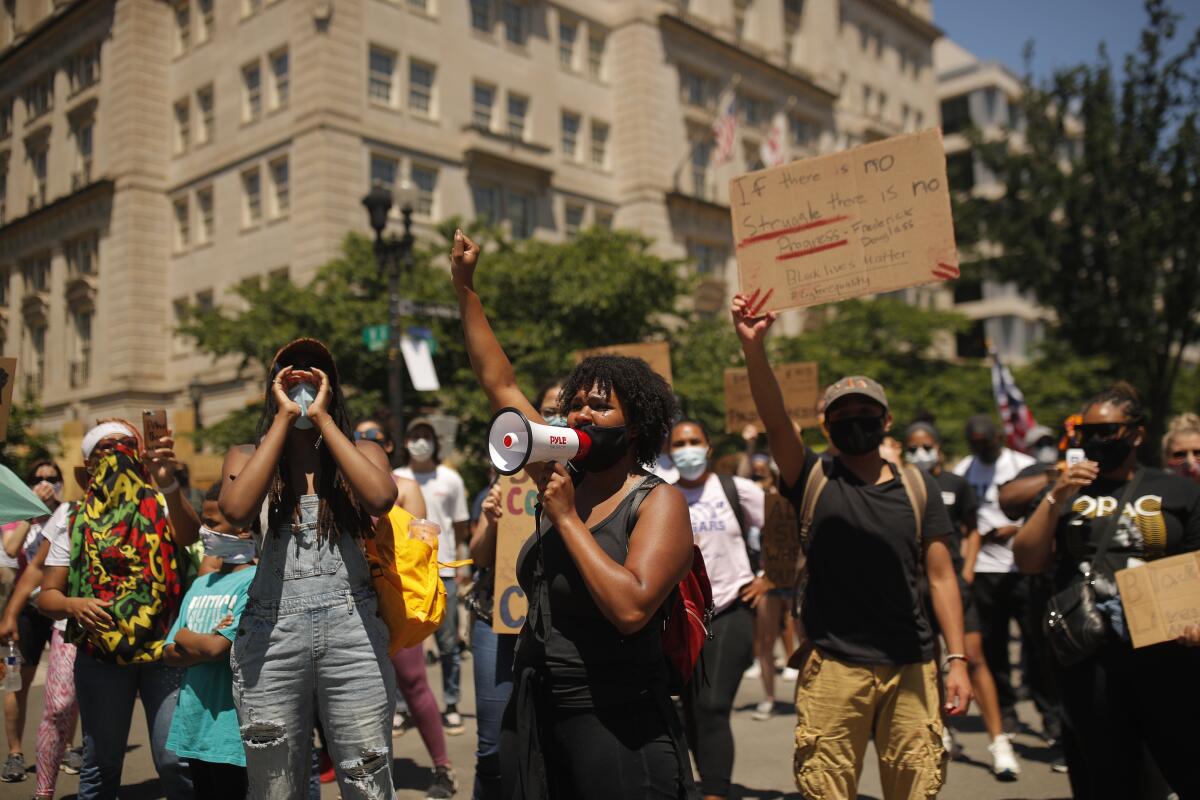Officials urge George Floyd protesters to get coronavirus tests

- Share via
NEW YORK — As New York City prepared to reopen after a more than two-month coronavirus shutdown, officials on Sunday lifted a curfew that was put in place amid protests of police brutality and racial injustice. But they also urged that demonstrators be tested for the coronavirus.
“Get a test. Get a test,” New York Gov. Andrew Cuomo urged people who have been participating in rallies and marches in memory of George Floyd.
He said the state planned to open 15 testing sites dedicated to protesters so they can get results quickly.
“I would act as if you were exposed, and I would tell people you are interacting with, assume I am positive for the virus,” Cuomo added.
The call is similar to what officials in Seattle, San Francisco and Atlanta have made following massive demonstrations, with free testing set up for protesters who may have been exposed to the virus.
“There is a pandemic going on out there. People are aware of that. I don’t think any of us have forgotten that’s happening,” Jennifer Cota, who was protesting in a Seattle suburb, told KCPQ-TV. “It’s still a risk a lot of people are willing to take.”
Demonstrations across the country Saturday were perhaps the largest one-day mobilization since Floyd died May 25 at the hands of a white Minneapolis police officer. The turnout continued around the globe Sunday even as U.S. cities lifted curfews imposed amid last week’s spasms of arson, assaults and smash-and-grab raids on businesses. Recent days of U.S. protests have been overwhelmingly peaceful.
New York City prepared to enter its first phase of reopening after shutdowns due to the pandemic. Between 200,000 and 400,000 people are expected to head back to the workplace Monday, with many using a subway system that most New Yorkers have avoided since March because of crowded conditions.
On Sunday, Mayor Bill de Blasio lifted the city’s 8 p.m. curfew put in place for the Floyd protests.
“Last night was the best by far,” De Blasio told reporters. “We had the biggest number of protesters, the fewest arrests, the fewest problems and that convinced me it was time for the curfew to go away. I have no intention of bringing it back.”
He maintained, however, that the city was still debating whether to enforce street closures later in the day. He also said he was “frustrated” by the large number of police officers who were not wearing face masks, describing it as painful to people who may perceive law enforcement was “flouting” social-distancing rules.
New York City police pulled back on enforcing the curfew Saturday as thousands took to streets and parks to protest Floyd’s death.
His body arrived in Texas for a final memorial service, said Houston Police Chief Art Acevedo. A viewing is planned for Monday in Houston, followed by a service and burial Tuesday in suburban Pearland.
Floyd, a 46-year-old out-of-work bouncer, died after a Minneapolis police officer pressed his knee into his neck for several minutes even after he stopped responding. Floyd’s death has inspired international protests and drawn new attention to the treatment of African Americans by police and the criminal justice system.
Other memorials have taken place in Minneapolis and Raeford, N.C., near where Floyd was born.
At the private service in North Carolina, mourners sang with a choir as a large photo of Floyd and a portrait of him adorned with an angel’s wings and halo were displayed.
“It could have been me. It could have been my brother, my father, any of my friends who are black,” said Erik Carlos of nearby Fayetteville. “It made me feel very vulnerable at first.”
More to Read
Sign up for Essential California
The most important California stories and recommendations in your inbox every morning.
You may occasionally receive promotional content from the Los Angeles Times.













